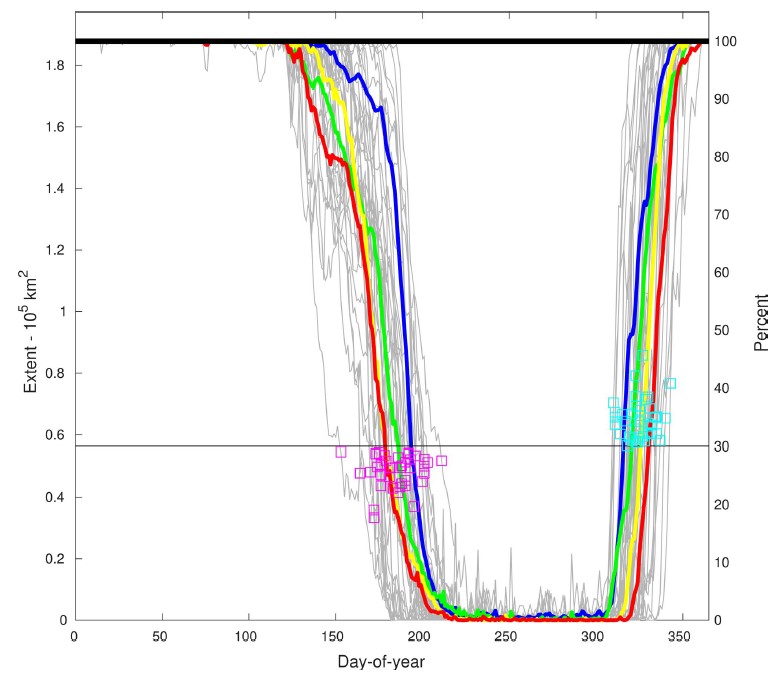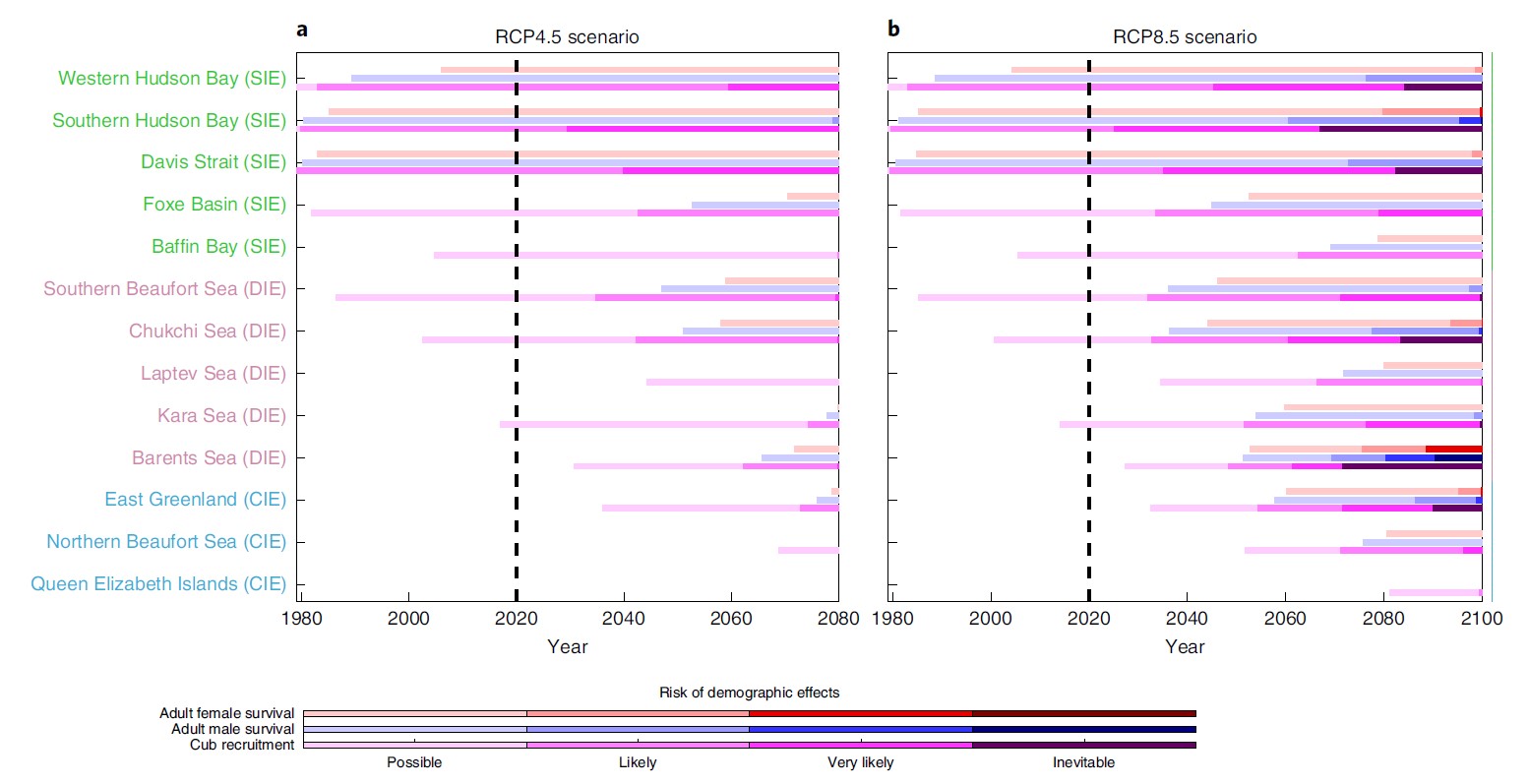

REVIEW
CLAIM: "Global warming is driving polar bears toward extinction. Polar bears could become nearly extinct by the end of the century as a result of shrinking sea ice in the Arctic if global warming continues unabated."
REVIEW
The claim has appeared in multiple media outlets, including The New York Times, The Guardian, BBC, Forbes, and Time, and has been shared on Facebook more than 18,000 times in total, according to Crowd Tangle. The claim is based on a study published July 2020 that projected range-wide declines in polar bear subpopulations under moderate and high greenhouse gas emissions scenarios due to losses of sea-ice habitat[1]. The article in The New York Times accurately describes results from this study.
Sea-ice loss is currently the most important threat to the long-term survival of polar bears[2,3]. Polar bears rely on sea ice to feed on seals (their primary prey), mate, establish dens, and move throughout their range[2,3]. During the summer, sea-ice melt forces polar bears ashore where they often fast for months at a time due to inadequate food supplies[1]. While polar bears have energy reserves that facilitate their survival and ability to recruit cubs (i.e., lactation) during these fasts, body reserves are also limited[1]. Loss of sea-ice habitat has already led to lower survival, reproduction, and body condition in some polar bear subpopulations, including the southern Beaufort Sea, Western Hudson Bay, and Southern Hudson Bay populations[4-7].
To estimate how and when sea-ice loss will impact survival and reproduction in 13 polar bear subpopulations, Molnár et al. (2020) calculated how long polar bears could fast before adult survival and cub recruitment rapidly declined. Although data about how sea-ice loss affects population demographics is limited for most subpopulations, Molnár et al. used data from a subpopulation (Western Hudson Bay) as a baseline because it already experienced extended periods of fasting as a result of sea-ice declines (see figure below).
Figure—Annual extent of sea ice in the Western Hudson Bay polar bear subpopulation derived from PMW data. Gray lines represent the daily extent of sea ice each year from 1979 – 2016 measured by satellite observations. Colored curves represent the means of the daily extent, with each color capturing a different time period: 1979-1988 (blue), 1989-1999 (green), 2000-2009 (yellow), and 2010-2016 (red).
The study authors then calculated the energy needs of fasting polar bears for 13 subpopulations based on this baseline, while using sensitivity analyses to account for uncertainties and differences among subpopulations[1]. Molnár et al. then estimated losses of sea ice under moderate and high greenhouse gas emissions scenarios (RCP4.5 and RCP8.5, respectively) to project when declines in adult female and male survival and cub recruitment passed critical thresholds.
As described in the study, “with high greenhouse gas emissions, steeply declining reproduction and survival will jeopardize the persistence of all but a few high-Arctic subpopulations by 2100. Moderate emissions mitigation prolongs persistence but is unlikely to prevent some subpopulation extirpations within this century,” (see figure below)[1].
Figure—Timelines of risk for when cub recruitment and adult survival of male and female polar bears will begin declining in 13 subpopulations across the species range. Subpopulations are listed along the y-axis and colored by ecoregion. Effects on adult female survival (orange), adult male survival (blue), and cub recruitment (magenta) are shown for each subpopulation under moderate (a) and high (b) greenhouse gas emissions scenarios.
As the reviewers explain below, The New York Times article accurately describes results from this study. In addition, this study is consistent with previous scientific studies predicting declines in polar bear subpopulations with continued loss of sea ice due to global warming[8-13].
SCIENTISTS’ FEEDBACK
Péter Molnár, Assistant Professor, University of Toronto Scarborough:
The article is accurate and summarizes our findings very well. I only have one extremely minor comment, which doesn’t affect the overall accuracy of this article. In the second paragraph, the author writes that “the loss of sea ice would force the animals onto land and away from their food supplies for longer periods”. In some cases (e.g. the Beaufort Sea populations), the animals may choose not to go on land but instead follow the ice as it retreats over the Arctic Basin. As these are deep, dark, unproductive waters, the effect is therefore the same as going on land (food-deprivation), and this omission does not affect the overall accuracy of the article.
Jennifer Kay, Associate Professor, University of Colorado Boulder:
I read the NYT article and thought it represented the findings well.
Andrew Derocher, Professor, University of Alberta:
The statement of “nearly extinct” is consistent with the findings of Hamilton et al. (2014) which stated “Under business-as-usual climate projections, polar bears may face starvation and reproductive failure across the entire Archipelago by the year 2100.”[8] Further, the study concluded with “Nevertheless, by 2100 all regions of the study area may cross the critical point-of-no-return, putting the persistence of the CAA [Canadian Arctic Archipelago] polar bear populations in jeopardy.” This study examined the Canadian Arctic Archipelago populations where sea ice is expected to persist the longest.
Castro de la Guardia et al. (2013) examined sea ice in Hudson Bay and that study stated “Our predictions suggest that the habitat of polar bears in WH [Western Hudson Bay] will deteriorate in the 21st century. Ice predictions in A1B [medium greenhouse gas emissions] and A2 [high greenhouse gas emissions] suggest that the polar bear population may struggle to persist after ca. 2050. Predictions under B1 [low greenhouse gas emissions] suggest that reducing GHG emissions could allow polar bears to persist in WH throughout the 21st century.”[9]
Thus, the Molnár et al. study is supported by both Hamilton et al. (2014) and Castro de la Guardia et al. (2013)[1,8,9]. The time frame and approach in these two studies is similar to that of Molnár et al. and use a fasting duration limit relative to sea ice loss estimation.
Regehr et al. (2016) stated “The estimated probabilities that reductions in the mean global population size of polar bears will be greater than 30%, 50% and 80% over three generations (35–41 years) were 0.71 (range 0.20–0.95), 0.07 (range 0–0.35) and less than 0.01 (range 0 – 0.02), respectively.”[10] Given that Molnár et al. consider a much longer timeframe and that it considers a severe climate change scenario (RCP 8.5) as the upper bound, the study is consistent with Regehr et al. (2016). They also examined a lower climate change scenario (RCP 4.5), which shows impacts on polar bears that would be consistent with projected changes noted by Regehr et al. (2016).[1,10]
The statements about extended fasting, shorter feeding period, and traveling more, are consistent with the broader literature addressed in the review by Stirling and Derocher (2012) and both empirical and projection studies by Stirling et al. (1999), Lunn et al. (2016), Pilfold et al. (2016), and Durner et al. (2017)[11,5,12,13].
In summary, I find that the statement is consistent with the published work being addressed and that the statement overall is consistent with the broader peer-reviewed literature on polar bears.
Ian Stirling, Adjunct Professor, University of Alberta:
Overall, I would say Molnar et al. 2020 should be regarded as scientifically correct, quantitative in terms of the data analyzed, and analytically supported[1].
I started and maintained the long-term monitoring of the polar bear population in Western Hudson Bay (WH). My early results were clear enough by the late 1990s for the analyses to be the first to confirm the negative effects of climate warming on polar bears. WH is the longest continuous data base on the effects of climate warming on polar bear abundance, survival, and reproduction anywhere in the Arctic. When I initially started the long-term monitoring of polar bears there it was because I wanted to learn more about the amount of natural variation inherent in the polar marine ecosystem because of its obvious importance to conservation practises. I had already seen the results of large scale interannual changes in the ecosystem on polar bears and ringed seals in the Arctic (Beaufort Sea) and on Weddell seals in the Antarctic and those experiences were enough to convince me that understanding more about natural fluctuations in the ecosystem was something we really needed to know a lot more about. It was only by the mid-1990s (the period identified by Molnar) that we began to realize from our data that something else was going on besides possible natural cycles and, because we had a long-term database, and the ability to continue the monitoring, that we were able to identify and confirm what was happening because of climate warming.
I think it is fair to say that the physiological parameters with respect to reproduction and body condition, etc. measured in WH could be reasonably applied to polar bears elsewhere. What such focused models projecting into the future do not take into account overall though of course is that the whole arctic marine ecosystem (and the interrelationships of all species) is changing because of climate warming and the speed of such changes will likely accelerate as time progresses so exactly what might happen specifically to polar bears as an icon species becomes more difficult to predict precisely the farther out we get. That said, the modelling approach remains invaluable for what it clearly indicates is coming our way soon, regardless.
I think a major strength of the Molnar paper is that it correctly assesses the populations (for which there are sufficient data) independently rather than as a single world population[1]. That appears to be the major weakness in the Hamilton et al. (2014) paper, which comes to the same conclusion as Molnar (see their Conclusions/Significance statement) but is based mainly only on bears in the Canadian Arctic Archipelago and treats the subpopulations resident there as a single population and not as several independent populations[8]. Still, the fact that these two papers basically come to a more or less identical conclusion, via different routes and levels of analysis is interesting.
While I think the Molnar paper is quite correct overall, I think it overlooks two important ecological situations which don’t weaken their overall conclusions but could have given them a bit more ecological depth of understanding of some important qualifications for some populations and might have been important to include, though the space restrictions in journals like Nature might preclude doing so.
In my opinion, a common flaw in almost all (if not all) the big overview papers that predict bears having problems loss of ice because of climate warming and then becoming extinct, or nearly so, by some date is that they tend to make a 1:1 relationship between the area of ice and its decline and the subsequent decline in the bears for nutritional reasons. However, ecologically, the relationship is much more complicated and geographically variable than a simple 1:1 relationship. Ringed seals, which are the major food source of polar bears throughout their range are reliant on having hard wind blown snow over the breathing holes of the adult females in their prime breeding habitat for giving birth to their young[14]. With the warmer weather and rain that will appear in most areas, probably at significantly increased levels well before 2100, the devastating decline in ringed seal reproduction and survival will have an immediate negative effect on the bears’ nutrition, survival, and reproduction[15]. We already know that reproductive failure of ringed seals (as seen on decadal scale intervals in the southern Beaufort Sea[16]) causes immediate and very strong negative effects on reproduction and survival of young polar bears as well as lowering the body condition in adults[17]. If such levels of loss of ringed seal pups is significant because of climate for several years in some populations, the negative effects on the bears there will be significant.
Also, there are major differences in the availability of different prey species for polar bears in different populations[18]. In particular, the role of some of these prey species to provide carrion in some populations that could help a smaller number of bears survive for a protracted period has been overlooked. For example, the potential for walrus populations (which will be less negatively impacted by climate warming in some areas) to provide a long-term potential food source, at predictable locations, for both predation and scavenging in several areas. Similarly, where whale carcasses resulting from natural mortality occur in predictable locations, they may provide a long-term food source for bears in areas such as Chukotka[19].
REFERENCES
- 1 – Molnar et al. (2020) Fasting season length sets temporal limits for global polar bear persistence. Nature Climate Change.
- 2 – Stirling et al (2018) Effects of climate warming on polar bears: a review of the evidence. Global Change Biology.
- 3 – Stern et al (2016) Sea-ice indicators of polar bear habitat. The Cryosphere.
- 4 – Bromaghin et al (2015) Polar bear population dynamics in the southern Beaufort Sea during a period of sea ice decline. Ecological Applications.
- 5 – Lunn et al (2016) Demography of an apex predator at the edge of its range: impacts of changing sea ice on polar bears in Hudson Bay. Ecological Applications.
- 6 – Regehr et al (2010) Effects of earlier sea ice breakup on survival and population size of polar bears in Western Hudson Bay. The Journal of Wildlife Management.
- 7 – Obbard et al (2016) Trends in body condition in polar bears (Ursus maritimus) from the Southern Hudson Bay subpopulation in relation to changes in sea ice. Arctic Science.
- 8 – Hamilton et al (2014) Projected polar bear sea ice habitat in the Canadian Arctic Archipelago. PLoS One.
- 9 – Castro de la Guardia et al (2013) Future sea ice conditions in western Hudson Bay and consequences for polar bears in the 21st century. Global Change Biology.
- 10 – Regehr et al (2016) Conservation status of polar bears (Ursus maritimus) in relation to projected sea-ice declines. Biology Letters.
- 11 – Stirling et al (1999) Long-term trends in the population ecology of polar bears in western Hudson Bay in relation to climatic change. Arctic.
- 12 – Pilfold et al (2016) Mass loss rates of fasting polar bears. Physiological and Biochemical Zoology.
- 13 – Durner et al (2017). Increased Arctic sea ice drift alters adult female polar bear movements and energetics. Global Change Biology.
- 14 – Smith et al (1975) The breeding habitat of the ringed seal (Phoca hispida). The birth lair and associated structures. Canadian Journal of Zoology.
- 15 – Stirling et al (2004) Implications of warm temperatures and an unusual rain event for the survival of ringed seals on the coast of Southeastern Baffin Island. Arctic.
- 16 – Stirling (2002) Polar bears and seals in the Eastern Beaufort Sea and Amundsen Gulf: a synthesis of population trends and ecological relationships over three decades. Arctic.
- 17 – Kingsley (1979) Fitting the von Bertalanffy growth equation to polar bear age–weight data. Canadian Journal of Zoology.
- 18 – Theimann et al (2008) Polar bear diets and arctic marine food webs: insights from fatty acid analysis. Ecological Monographs.
- 19 – Laidre et al (2018) Historical and potential future importance of large whales as food for polar bears. Frontiers in Ecology and the Environment.




